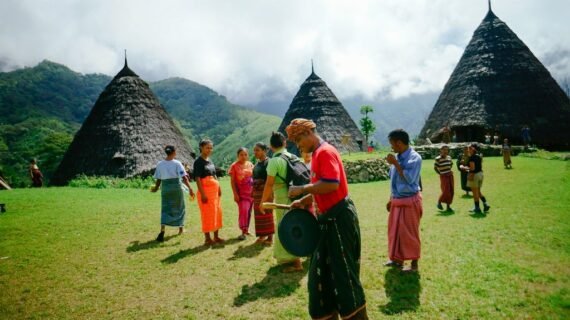Nestled amidst the lush mountains of Flores Island, Indonesia, Wae Rebo Village offers a unique glimpse into the lives and traditions of an ancient Manggarai community. This remote village is renowned for its distinctive, cone-shaped traditional houses known as Mbaru Niang, which stand as a testament to the cultural richness and architectural ingenuity of the Manggarai people. Recognized as a UNESCO World Heritage site, Wae Rebo provides not only a breathtaking escape from the modern world but also an invaluable opportunity to experience and participate in the preservation of a cultural legacy.
The Journey to Wae Rebo
Reaching Wae Rebo is an adventure in itself, beginning with a scenic drive to the village of Denge, the last accessible point by motor vehicle. From there, visitors embark on a challenging yet rewarding trek, approximately 3-4 hours, through dense forests and steep mountain paths. This trek is not just a physical challenge but also a pathway through the stunning natural landscapes of Flores, offering panoramic views and encounters with diverse flora and fauna.
Life in Wae Rebo
Upon arrival, visitors are welcomed with warm hospitality by the villagers, who share their homes, culture, and stories. The village consists of seven traditional houses, all built in the same distinctive circular design with thatched roofs that swoop down nearly to the ground, a design that has been passed down through generations. These structures are not only homes but also communal centers where daily activities, rituals, and ceremonies take place.
Visitors have the opportunity to immerse themselves in the daily life of Wae Rebo by participating in traditional weaving, observing coffee processing, or joining in the preparation of local cuisine. The experience is a deep dive into a way of life that prioritizes community, tradition, and harmony with nature.
Cultural Insights and Sustainable Practices
Wae Rebo is more than a village; it is a living model of sustainability. The community’s reliance on and respect for the natural environment is evident in their sustainable farming practices and use of local materials for building and daily needs. The village’s isolation has preserved not only its architectural styles but also its ecological and social systems, which have evolved over centuries.
Why Visit Wae Rebo?
Visiting Wae Rebo is a transformative experience that connects travelers with the heart of Manggarai culture. It offers a profound understanding of the community’s connection to their environment, the significance of their ancestral traditions, and the efforts required to maintain their way of life in the face of modern pressures. It is an educational journey, one that teaches the importance of cultural diversity and ecological stewardship.
Conclusion
For those looking to explore beyond the typical tourist paths and delve into a deep cultural exchange, Wae Rebo Village is a perfect destination. It promises not just a scenic retreat but also an enlightening experience, offering insights into a way of life that has remained unchanged for generations. The journey to and from Wae Rebo is a vivid reminder of the beauty and resilience of cultural heritage in our rapidly changing world.

